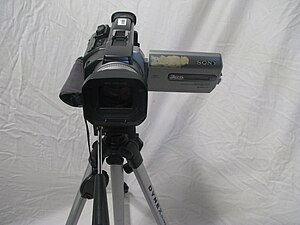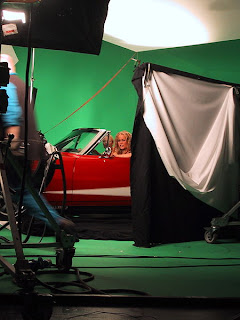 Image via Wikipedia
Image via Wikipedia Three Steps To Add the Power of Video to Your Website
1. Shoot Your Video
2. Upload It To YouTube
3. Link or Embed Your Video Broadcast
What should your first video message be?
If a visitor stopped by your show room you'd take the opportunity to show them around. Do the same thing on your website or blog. When a visitor arrives, welcome them to your site with your instruction video. In essence, you want to show them around your "virtual Internet showroom."
Tell them how you're different and the benefits you or your products offer. If your site has links, then tell your visitor what information they will find if they follow those links.
I offer lessons and instructions online. I play the piano and offer certain music resources to take your piano playing to the next level.
Step 1: Shoot Your Video
Set up your camera and position yourself about two or three feet in front of it and start talking. In the beginning, I used a digital camera and set it on a tripod. Then I set the camera on video and sat down and started talking.
Don't worry about what you will say, just start talking and recording. If you were a first time visitor to your website what would you be looking for and what would you want to know?
Don't worry about scripting out what you will say. Just talk off the top of your mind and don't be afraid to record several takes. The delete button is powerful and allows you to re-take the shot many times over.
Then watch them back and pick the best one. The exercise of being in front of the camera and just talking will help you perfect what you say. It will also help you get past your fear of being in front of the camera. By recording several takes, it will help you to look, sound and feel natural. And that's important! Remember to smile and just be yourself.
One of the greatest powers of using video in your marketing is that it gives your customers and prospects the opportunity to meet you face to face. Once you are happy with the take, put it up on YouTube.
Step 2: Upload to YouTube
If you do not yet have an account go to www.youtube.com and sign up for a free account. Once you have it set up, which will take a few minutes, connect your video camera to your computer and upload your video to YouTube. Most video cameras come with software that may require you to transfer the video to your computer before you can move it to YouTube.
The hardest part of the whole process is often getting the video off your camera. If you have trouble then you might want to consider investing in a video camera that is made specifically for putting video onto computer or uploading it to the Internet.
Step 3: Link or Embed Your video for broadcast.
Once you have your video on YouTube you will find two different sets of Internet coding to the right of your video. The URL code lets you link people to your YouTube video and the Embedded code lets you place that video directly onto your Website.
I recommend you place your videos on your Website. Keep your visitors on your site rather than sending them away to another site. If you maintain your own Website then simply copy and paste this code onto your Web page. If you have someone who maintains it for you, then send the code to them. It can save you hundreds of dollars in getting video on your Website. The key is to just do it.
As a music teacher, I enjoy recording students playing their favorite songs and then sharing the link with family members and friends. I also have enjoyed making a video of pirate images and children's books with background music on one of my blogs.
Once you have put a welcome video on your website, there is a lot more you can do. Most importantly, put your website or blog URL in the Description Box. That way you will be directing more traffic to your site and increase effective newsletter sign ups.
Indeed there is power in adding video to your website.
http://ezinearticles.com/?Video-Making-and-Marketing&id=5353121
1. Shoot Your Video
2. Upload It To YouTube
3. Link or Embed Your Video Broadcast
What should your first video message be?
If a visitor stopped by your show room you'd take the opportunity to show them around. Do the same thing on your website or blog. When a visitor arrives, welcome them to your site with your instruction video. In essence, you want to show them around your "virtual Internet showroom."
Tell them how you're different and the benefits you or your products offer. If your site has links, then tell your visitor what information they will find if they follow those links.
I offer lessons and instructions online. I play the piano and offer certain music resources to take your piano playing to the next level.
Step 1: Shoot Your Video
Set up your camera and position yourself about two or three feet in front of it and start talking. In the beginning, I used a digital camera and set it on a tripod. Then I set the camera on video and sat down and started talking.
Don't worry about what you will say, just start talking and recording. If you were a first time visitor to your website what would you be looking for and what would you want to know?
Don't worry about scripting out what you will say. Just talk off the top of your mind and don't be afraid to record several takes. The delete button is powerful and allows you to re-take the shot many times over.
Then watch them back and pick the best one. The exercise of being in front of the camera and just talking will help you perfect what you say. It will also help you get past your fear of being in front of the camera. By recording several takes, it will help you to look, sound and feel natural. And that's important! Remember to smile and just be yourself.
One of the greatest powers of using video in your marketing is that it gives your customers and prospects the opportunity to meet you face to face. Once you are happy with the take, put it up on YouTube.
Step 2: Upload to YouTube
If you do not yet have an account go to www.youtube.com and sign up for a free account. Once you have it set up, which will take a few minutes, connect your video camera to your computer and upload your video to YouTube. Most video cameras come with software that may require you to transfer the video to your computer before you can move it to YouTube.
The hardest part of the whole process is often getting the video off your camera. If you have trouble then you might want to consider investing in a video camera that is made specifically for putting video onto computer or uploading it to the Internet.
Step 3: Link or Embed Your video for broadcast.
Once you have your video on YouTube you will find two different sets of Internet coding to the right of your video. The URL code lets you link people to your YouTube video and the Embedded code lets you place that video directly onto your Website.
I recommend you place your videos on your Website. Keep your visitors on your site rather than sending them away to another site. If you maintain your own Website then simply copy and paste this code onto your Web page. If you have someone who maintains it for you, then send the code to them. It can save you hundreds of dollars in getting video on your Website. The key is to just do it.
As a music teacher, I enjoy recording students playing their favorite songs and then sharing the link with family members and friends. I also have enjoyed making a video of pirate images and children's books with background music on one of my blogs.
Once you have put a welcome video on your website, there is a lot more you can do. Most importantly, put your website or blog URL in the Description Box. That way you will be directing more traffic to your site and increase effective newsletter sign ups.
Indeed there is power in adding video to your website.
http://ezinearticles.com/?Video-Making-and-Marketing&id=5353121
All the best, LadyD









